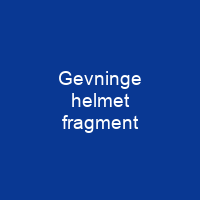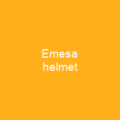The Gevninge Helmet Fragment: A Glimpse into Viking Age Armor
Imagine stepping back in time to the Viking Age, where warriors donned intricate helmets adorned with symbols and protective features. One such fragment, discovered in 2000 during an excavation in Denmark, offers a fascinating glimpse into this era of history. The Gevninge helmet fragment is not just a piece of metal; it’s a window into the lives of Viking warriors and their connection to mythological figures.
Unearthing History
The Gevninge helmet fragment, found in 2000 during construction work, measures an impressive 8 cm wide by 5 cm tall. Crafted from bronze and gilded with intricate details, this piece is more than just a relic—it’s a testament to the craftsmanship of the Viking Age.
Its design features a stylized eyebrow with individual hair-like grooves, along with three holes at the top for attachment to the helmet cap and three at the bottom for face protection. This fragment is one of only two Scandinavian eyepieces discovered alone, suggesting it may have been intentionally deposited as an invocation to Odin, the one-eyed god.
Significance in History
The Gevninge helmet fragment’s significance extends beyond its physical attributes. It was found in a settlement dating between 500 and 1000 AD, placing it firmly within the Viking Age or late Nordic Iron Age. This discovery aligns with the historical context of Beowulf, an epic poem that describes the journey to Heorot, a great mead hall.
Just as Beowulf was met by a mounted lookout upon his arrival, the Gevninge fragment provides insight into the military hierarchy and the importance of adornments in identifying rank. The fragment’s presence suggests that its wearer held an esteemed position, perhaps even connected to the king through family or loyalty.
Exhibitions and Exhibits
The Gevninge helmet fragment has traveled far beyond Denmark, exhibiting internationally from 2013 to 2015. It was part of the Vikings: Life and Legend exhibition at the British Museum, alongside other seventh-century grave finds from the area.
This international exposure highlights the fragment’s importance in connecting historical fact with legend. Its discovery near Lejre, a center of power during the Iron and Viking Ages, further strengthens its link to Beowulf’s setting. The proximity to Lejre suggests that Gevninge may have been “the Port of Lejre,” guarding against enemy raiders.
Legends and Reality
The Gevninge helmet fragment serves as a bridge between historical fact and legend, much like the characters in Beowulf. It provides tangible evidence of the rich cultural tapestry that existed during this period, blending practical utility with mythological symbolism.
By examining such artifacts, we gain a deeper understanding of the Viking Age’s social structures, military practices, and religious beliefs. The fragment’s intricate design and strategic placement on the helmet highlight the importance of appearance in both battle and ceremonial contexts.
Ancient Artifacts and Modern Insights
The Gevninge helmet fragment is just one piece in a larger puzzle that archaeologists and historians are piecing together. Through careful study, these artifacts offer insights into the daily lives of Vikings, their beliefs, and their interactions with neighboring cultures.
By exploring such relics, we not only learn about the past but also gain a greater appreciation for the enduring legacy of Viking culture in our modern world. The Gevninge fragment is more than just an artifact; it’s a story waiting to be told.

The Gevninge helmet fragment is a captivating piece that bridges the gap between history and legend, offering us a tangible connection to the Viking Age. By studying such artifacts, we uncover not only the practical aspects of ancient warfare but also the rich cultural and mythological tapestry that defined this era.
You want to know more about Gevninge helmet fragment?
This page is based on the article Gevninge helmet fragment published in Wikipedia (retrieved on November 28, 2024) and was automatically summarized using artificial intelligence.







